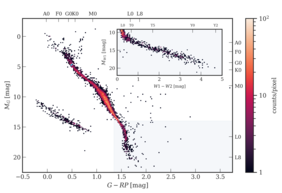The recently published CNS5 catalogue (The Fifth Catalogue of Nearby Stars) is an update to the Gliese-Jahreiß Catalogue of Nearby Stars and contains all known objects located within 25 parsecs (about 81.5 light-years) of the Sun.
It contains in total 5931 objects, including 5230 stars and 701 brown dwarfs. Of the stars, 4946 are main-sequence stars (stars that are still burning hydrogen in their cores), 20 are red giants (stars that have exhausted their supply of hydrogen and are expanding), and 264 are white dwarfs (remnants of dead stars that have exhausted their fuel and are cooling off). An update was required, as the most recent publicly available version of the catalogue of nearby stars was published more than 30 years ago and was entitled the Preliminary Version of the Third Catalogue of Nearby Stars (Gliese & Jahreiß 1991). The fourth version of the catalogue, CNS4, had been prepared but never published.
The Colour-magnitude diagram (CMD) for all CNS5 objects in both Gaia EDR3 and WISE photometric bands is one of the Gaia Images of the Week relating to the CNS5.
While the majority of the objects (87%) in the Fifth Catalogue of Nearby Stars are coming from Gaia EDR3, a variety of catalogues and surveys is needed to construct a truly complete catalogue. The Gaia EDR3 catalogue does not contain the brightest stars, thus information from the Hipparcos Catalogue for these brighter stars was added. To complement for optically faint objects, like brown dwarfs, information from ground-based infrared parallax surveys (Best et al. 2021; Kirkpatrick et al. 2021) was added as well.
ORIGINAL PUBLICATION
"The Fifth Catalogue of Nearby Stars (CNS5)"; A. Golovin, S. Reffert, A. Just, S. Jordan, A. Vani, H. Jahreiß; 2023; to be published in Astronomy & Astrophysics (see DOI https://www.aanda.org/component/article?access=doi&doi=10.1051/0004-6361/202244250)
ADDITIONAL INFORMATION
Gaia Image of the Week: Meet your neighbours: CNS5 - the fifth catalogue of nearby stars
Gliese-catalogue at ARI: https://wwwadd.zah.uni-heidelberg.de/datenbanken/aricns/gliese.htm
Gaia@ARI: https://zah.uni-heidelberg.de/gaia
ADDITIONAL MEDIA
Video annimation of the updated Catalogue of Nearby Stars 5 (CNS5): https://youtu.be/MuWtZE3klj0
Link to related Gaia ESA tweet: https://twitter.com/ESAGaia/status/1618197151619895297?s=20

